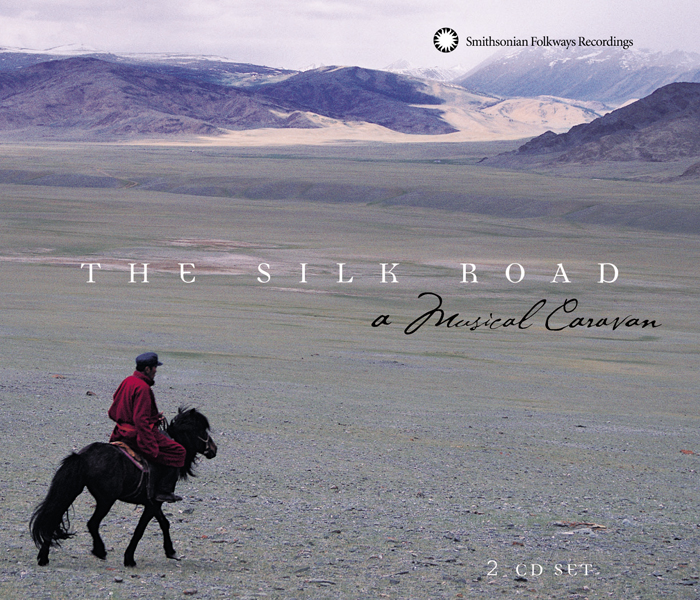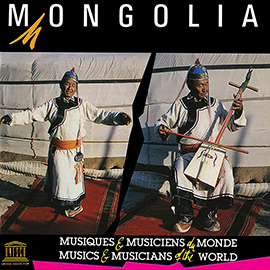Summary
Explore rural nomadic life in Mongolia and the highly impressionistic music and arts of the Central Asian steppes. Students learn to imitate sounds of the natural environment through improvised dance, instrumental performance, and throat-singing.
Suggested Grade Levels:3-5
Country:Mongolia
Region:Asia
Culture Group:Buryatia
Genre:Throat Singing
Instruments:Voice, Percussion
Language:Mongolian
Co-Curricular Areas:Social Studies, Dance
National Standards:2, 3, 6, 8, 9
Prerequisites:None
Objectives:
- Critical and contextual listening
- Awareness and understanding of various styles of Mongolian music: tatlaga story-song, long song, bielgee dance, and khöömei singing Transpose a pentatonic melody for their own instrument
- Imitating sounds of the natural environment through improvised dance and instrumental music performance
- Understanding cultural and artistic facets of rural nomadic life in Mongolia
- Gaining awareness for the highly impressionistic music and arts of the Central Asian steppes
Material:
- Recording of “The Gallop of Jonon Khar” from The Silk Road: A Musical Caravan
- Recording of “The River Herlen” from The Silk Road: A Musical Caravan
- Smithsonian Folkways Throat Singing Video
- Map of Mongolia
- Pictures of the Mongolian Steppes, Mongolian Horses, Mongolian Gers, and the Morin Khuur
- Optional: a projector adapted for PowerPoint presentations and a laptop computer with Windows PowerPoint software application
- Blank white or colored paper
- Colored crayons, pencils or pens
Lesson Segments:
- The Story of the Mongolian Horse Head Fiddle (National Standards 2, 6, 9)
- The Musical Ger (National Standards 2, 6, 8, 9)
- Scenery in Mongolian Long Song (National Standards 6, 8, 9)
- Khöömei Singing: Reflecting Nature Sounds of the Steppes (National Standards 3, 6, 9)
1. The Story of the Mongolian Horse Head Fiddle

“The Gallop of Jonon Khar”
from The Silk Road: A Musical Caravan (2002) | SFW40438
“The River Herlen”
- If possible, project or share pictures of the Mongolian Steppes and Mongolian horses.
- Play “The Gallop of Jonon Khar” on repeat.
- Briefly explain to the students that “The Gallop of Jonon Khar” is a tatlaga—a story told with instrumental music—about the fabled origin of the morin khuur, the national instrument of Mongolia
- “Morin” is the Mongolian word for horse
- Listen for the sound of a galloping horse in the music
- Invite seven student volunteers to read alternating lines of the “Black Jonon” story to the music, still playing on repeat. Hand each student volunteer a line from the story to read:
Once there lived a herder on the wide, swaying grasslands of Mongolia.
He was given a magical winged horse by a powerful shaman!
This horse was named Jonon, and was the color of the darkest night sky.
After herding his sheep over the long daylight hours, the herder mounted the winged Jonon and flew great distance to meet his beloved.
Another woman became jealous of the herder and arranged for someone to cut off Jonon's wings.
Jonon fell and died, and from his bones and skin the grieving herder created a fiddle on which he played songs about his horse.
This is one of his songs. - Stop the music and share pictures of a morin khuur instrument. “Representing the importance of horses to Mongolian life and culture, a carving of a horse head is positioned on top of the morin khuur. The bow and the two strings are made of horse hair.”
- Explain the prominence and role of the morin khuur in Mongolian music, cultural ceremonies and dance
- Hand out various musical instruments, (misc. percussion, hand drums, etc.), and invite students to mimic horse hooves
- Imitate that of a walk, trot and gallop
- “Which other animal steps can you play in music?”
- Accompany “The Gallop of Jonon Khar” with musical animal footsteps
- Collect instruments and engage brief student discussion about morin khuur.
- “Which other musical instruments resemble animals—in appearance or sound?”
Assessment:
Are students able to discuss the material in an age-appropriate manner? Are students able to mimic the different gaits of a horse using non-pitched percussion instruments?
2. The Musical Ger
- If possible, project a picture of a Mongolian ger.
- Play “The Gallop of Jonon Khar” on repeat.
- Seat the class in a circle and explain that they now occupy an imaginary ger during a characteristically snow-driven, -40° winter night of the Steppes
- Elaborate on the geography of the Mongolian Steppes (vast Central Asian grasslands) and the nomadic lives of Mongolian herders.
- If possible project or share a map of Mongolia and the Steppes of Central Asia
- Hand out various musical instruments and invite the students to accompany the music, playing the sound of a horse gallop.
- Invite two or three students each turn to dance a traditional Mongolian Bielgee to the music.
- Briefly explain that the Bielgee dance accompanies many facets of Mongolian life and cultural ceremonies, including entertainment during such long confined winter nights, and primarily uses improvised movements of the upper body (“There isn’t that much room to move around in a ger!”) to show the story of a tatlaga
- Loosely direct dancing students to show various herder doings: riding horses, herding sheep, etc.
- Stop the music and engage in a brief student discussion about the life of Mongolian nomadic herders.
Assessment:
Are students able to discuss the material in an age-appropriate manner? Are students able to imitate the sound of a gallop on non-pitched percussion instruments? Are students able to dance a traditional Mongolian Bielgee?
3. Scenery in Mongolian Long Song
- Hand out paper and drawing supplies to the students.
- Direct the students to write “Mongolian Long Song – The River Herlen” on the top of their blank paper
- Briefly provide a background for Mongolian long song, explaining that the syllables of the words in long song extend expressively in order to convey their meaning.
- “This four-minute song only contains ten words.”
- “This song tells the sadness of a younger brother lamenting the disappearance of his older sibling, while contemplating the wide open landscape that surrounds the River Herlen.”
- Explain that the accompanying instrument is the morin khuur
- As the text and music of long song centers around the imagery of a particular place, ask the students to draw the scene that they hear in “The River Herlen”.
- Play “The River Herlen” on repeat while the students draw scenery
- Stop the music and invite students to share their drawings.
Assessment:
Are students able to successfully draw out the scenery they hear within the music?
4. Khöömei Singing: Reflecting Nature Sounds of the Steppes

Video: Throat-singing, a guttural style of singing or chanting, is one of the world's oldest forms of music. It is predominantly practiced in rural areas of Central Asia, where it is called khöömei. The herder/hunter lifestyle in rural Central Asia, with its reliance on the natural world and deeply felt connection to the landscape, is reflected in this vocal tradition. Throat-singers often imitate sounds of the natural surroundings—animals, mountains, streams, and the harsh winds of the steppe.
- Play the Smithsonian Folkways throat-singing video.
- Direct questions to the students about the khöömei singing excerpt before playing the video a second time.
- What kinds of sounds in nature does the khöömei singing resemble? Particularly, which animals or parts of the natural landscape of the Mongolian steppes resonate in this khöömei singing?
- How many different sounds do you hear simultaneously in this singing?
- After watching the video a second time, draw answers and comments from the students about characteristics of the khöömei singing.
- Discuss the categories and technique of khöömei singing: nose, throat, etc.
- Briefly explain the physics of overtones in sound.
- While singing a comfortable drone pitch on the sound “Oh”, invite the students to elicit particular overtones by slowly rolling the sides of their tongues.
- Approximate the position by slowly sounding out the name “Oreo” (as in Oreo cookie)
- Have them repeat until they discover the presence of a ringing whistling quality in their pitch
Assessment:
Are students able to discuss the material in an age-appropriate manner? Are students able to experiment with khöömei singing and produce various overtones?
Extension: The Cup Dance
- Hand out plastic drinking cups filled with beans to the students (Mongolians use water).
- Play “The Gallop of Jonon Khar” and invite the students to improvise a bielgee dance where they balance their cup of beans on some part of their body (without spilling their beans!).
- Invite students to imitate particular animal movements or herding chores, either in unison or individually.
Additional Resources:
- Mongolian Arts and Culture
- Mongolian National Arts Council
- American Museum of Natural History, The Mongolia Exhibit,
- National Geographic, “The Story of Weeping Camel”,
- The Story of the Weeping Camel, feature length DVD co-released by National Geographic World Films and THINKFilm






